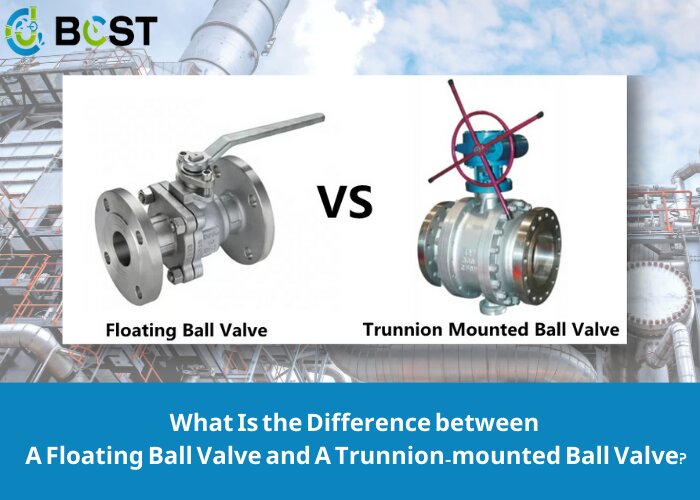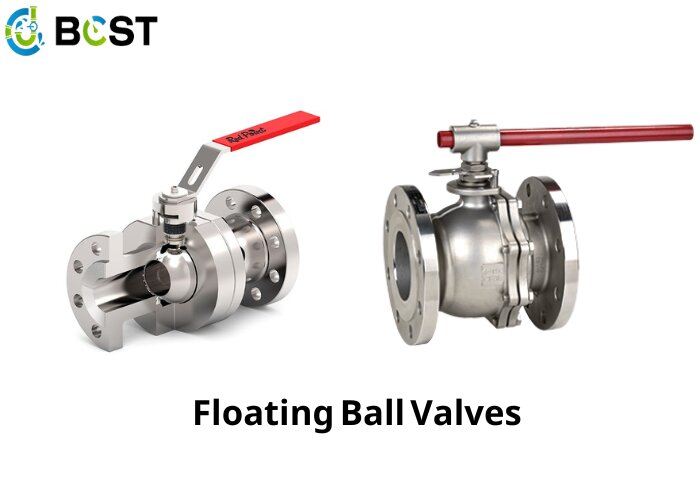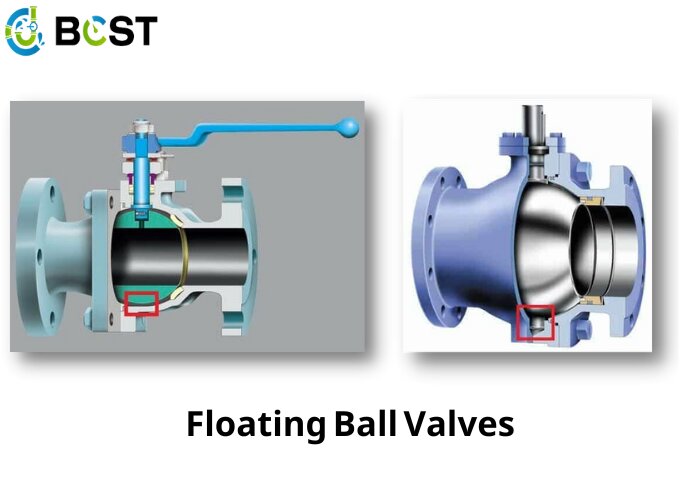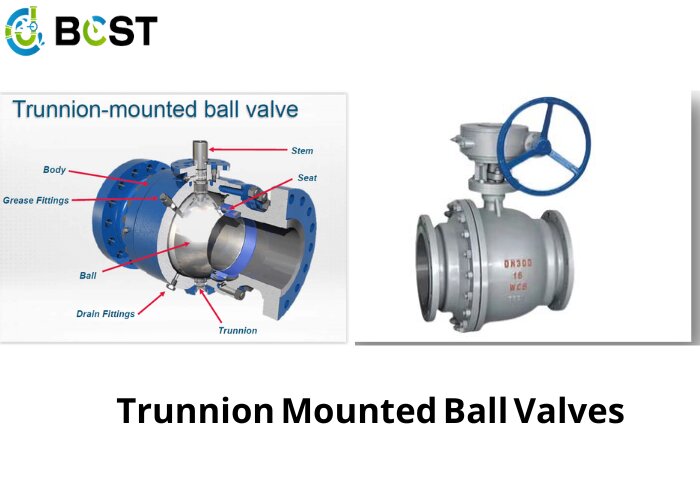
In this blog. We will talk about the world of the industrial valves deeply. During today’s discussion, we will talk about the difference between two main ball valves: the floating ball valve and the trunnion- mounted ball valve. The design of two valves plays an important role in various industries, each design has its special function and application. Learning the difference between them is beneficial for you to choose valves for your specific needs. Therefore, let us talk about the world of the floating ball valve and the trunnion-mounted ball valve, compared with their structure, and function, and to help you make your best choice for your operation.
What Are Floating Ball Valves?

Floating ball valves, as the name implies, have a ball that flows inside the valve’s body. The ball is attached to a stem that is controlled by a handle. The ball is connected to a lever that controls the opening and closing of the valve. Floating ball valves are utilized in numerous industries, including oil and gas, chemical processing, and water treatment.
Floating ball valves are often used in applications with high accuracy. Floating ball valves have a ball that is free to move up and down, creating a tight seal. Floating ball valves are therefore ideally suited for applications where a small amount of leakage is acceptable.
Floating ball valves come in a variety of materials, including brass, stainless steel, and plastic. The material used depends on the purpose of the valve. For example, a plastic floating ball valve would best suit an acidic environment, while a brass ball valve would be best for a high-temperature application.
How Does Floating Ball Valves Work?

A floating ball valve is made up of three major components:
- An actuator lever
- A stem
- A floating ball
- The actuator stem is the outermost component that opens or closes the flow of fluid. When turned at an angle of 90 degrees, it rotates the stem, which turns the ball to the open or closed position.
- The ball is not mounted to the bottom of the valvebut is supported only by a fixed polymer ring and seat.
- When the valve is closed, media pressure forces the ball against the seat. This provides a tight seal and stops the flow immediately. However, since the ball is not supported, the high-pressure level cannot be distributed to the seat to minimize the force on the ball. Therefore, floating ball valves are only suitable for low to medium-pressure applications at normal temperatures. If necessary, floating ball valves can also be customized to make them suitable for cryogenic applications.
- A quality floating ball valve should have an anti-static and anti-blowout stem design for relief management and leakage control. This means that the stem stays in place and does not leak, even when the pressure rises or the fluid surges. The flexible soft seat is critical because it creates a seal around the float, stopping the flow of media.
The Benefits and Drawbacks of a Floating Ball Valve
- Floating ball valves are commonly used in a variety of industrial and commercial applications. The ball in this type of valve is designed to float on top of the fluid to achieve a tight seal while using minimal force. While floating ball valves have many advantages, they also have some disadvantages.
PROS
- It can be used for a wide range of fluids.
- Easy to operate
- Good for tight spaces
- Low maintenance
CONS
- Certain fluids may cause the ball to stick.
- It can be difficult to repair
- Not suitable for high-pressure applications
Applications of a Floating Ball Valve
Emergency shut-off systems- Pipeline systems, such as those involving fuels, water, or critical gases, often require a fast-responding shut-off valve in emergencies. This type of ball valve is unmounted, so it works fast and is therefore suitable for SIL 3 emergency shut-offs.
Water Supply System – The water distribution system needs to maintain pressure at an optimal level to maintain water flow and prevent air pockets from restricting water flow. Water flow must also be managed to avoid overflow. Because it is pressure-sensitive and may open and shut as needed based on pressure circumstances, a floating ball valve is an excellent choice for water system control.
Pipeline Pressure Relief – Pipeline Pressure Relief – Pipeline pressure control is critical to avoiding pipeline ruptures and other disasters. A floating ball valve can be added in a pipeline as a pressure outlet valve as it takes on the pressure while remaining intact, instead of a mounted ball valve that could sometimes blow out.
A trunnion ball valve is a type of valve that uses a sphere that is held in place by two trunnions or struts. The ball in this design can be rotated in place to open or close the valve. These ball valves are specialized valves that are widely used in various industries. These valves are carefully designed to provide superior performance in critical applications. Trunnion ball valves come in a variety of sizes and pressure ratings to meet the needs of various industries.
Some industries that commonly use trunnion ball valves include the oil and gas, power generation, and chemical processing industries. These valves are also widely used in applications where there is a need for a high-quality valve that can withstand extreme temperatures and pressures.
- The trunnion ball valve consists of 4 main components:
- An actuator lever
- A stem
- A ball
- A trunnion
The trunnion is the base of the ball. At the top end, the ball is linked to the stem and connected to an exterior actuator lever. A flanged trunnion ball valve has spring-loaded seats and a polymer ring insert between the trunnion and the ball. To keep the ball in place, the springs apply pressure to it. Along with the polymer rings, they also reduce friction as the ball spins.
The center of the sphere is hollow to facilitate media flow. Full bore means that the hollow diameter of the ball is the same as the diameter of the pipe in which it is installed. A radius ball has a hollow portion with a diameter smaller than the diameter of the pipe.
As the actuator twists, the stem to which it is attached rotates similarly. These actions cause the ball to rotate on the trunnion to the open or closed position. Seals in the seat and stem prevent fluid from seeping out of the piping during or after flow. The adjustable gland packing box also helps the valve to withstand different pressures.
A conventional trunnion ball valve would additionally contain two bleeders for depressurization purposes.
Trunnion ball valve construction makes it suitable for high-pressure and high-temperature fluid management applications.
The Benefits and Drawbacks of a Trunnion Ball Valve
Trunnion ball valves are one of the most popular products on the market today. From oil and gas to water and wastewater treatment, trunnion ball valves can be used in a variety of industries and applications. But what are the strengths and weaknesses of trunnion ball valves?
PROS:
- Trunnion ball valves are extremely strong and can sustain extreme pressure.
- They are simple to use and open and close rapidly.
- Trunnion ball valves have a good seal and can be used with various liquids and gasses.
CONS:
- Trunnion ball valves can be expensive.
- If they break, they can be difficult to repair.
Trunnion ball valves are large and bulky, which can make installation a challenge in some cases
Chemical production plants. The transfer of chemicals through pipelines during the production process requires strict management. Corrosive chemicals are used because leaks and high reaction temperatures can endanger employees or the environment. Trunnion ball valves, with full seals added during manufacturing and high-temperature resistance, are ideal for safely managing such fluids.
Petroleum industry applications. API 6D trunnion ball valves are recommended for use in the petrochemical industry because of their leak-proof and high-pressure-resistant features. These features are particularly useful in high-flow petrochemical pipelines and gas lines where pressure needs to be carefully managed.
Power Generation. Power generation uses different fuels. For example, geothermal power uses steam, while hydroelectric power uses water.
The material used to generate electricity must be released into the system in measured units in each case. Trunnion ball valves have the ability to handle large-scale, high-temperature, and high-pressure activities and are ideal for managing the flow of such media.
Key differences between floating ball valves and trunnion-mounted ball valves
There are two types of ball valves: floating ball valves and trunnion ball valves. A ball valve is a valve that uses a sphere to control the flow of fluid. When the valve is open, the hole in the center of the sphere allows fluid to pass through. When the valve is closed, the sphere is turned so the hole is blocked and fluid cannot pass through.
So, what are the critical differences between a trunnion and a floating valve? The biggest distinction is in the ball’s design. In a floating ball valve, the ball is free to float within the valve’s body. The ball in a trunnion ball valve is connected to a trunnion, which is a short cylindrical piece of metal. The trunnion is the fulcrum of the ball and has the advantage of reinforcing the valve and preventing the ball from rupturing or deforming under high pressure.
Floating ball valves are less likely to leak and easier to maintain than trunnion ball valves. They are also less expensive. On the other hand, trunnion ball valves have superior flow characteristics and can handle higher pressures.







